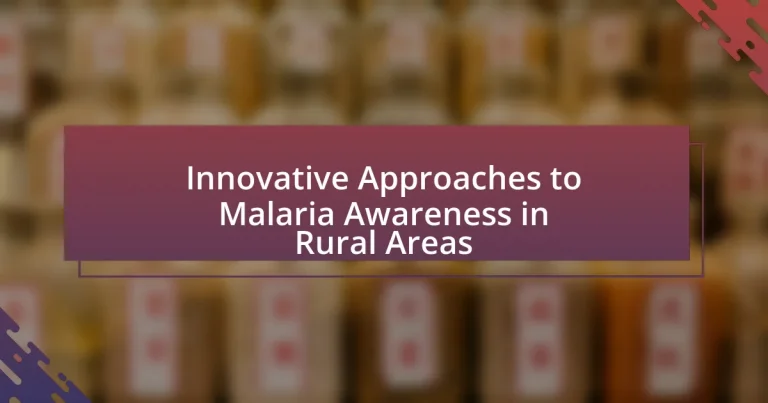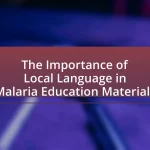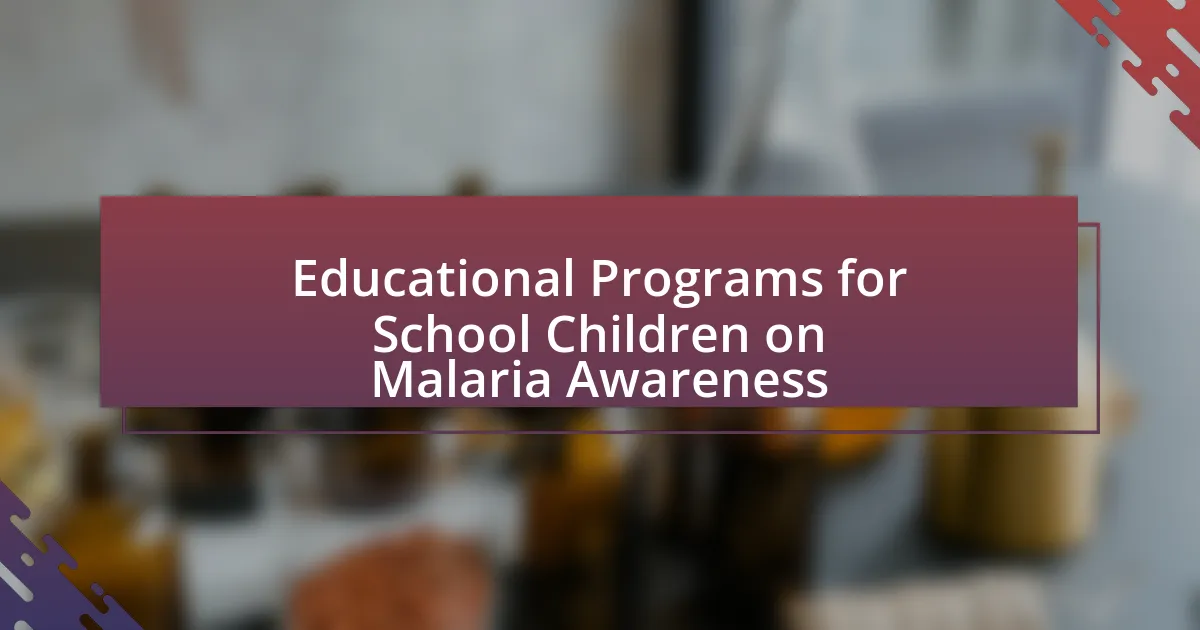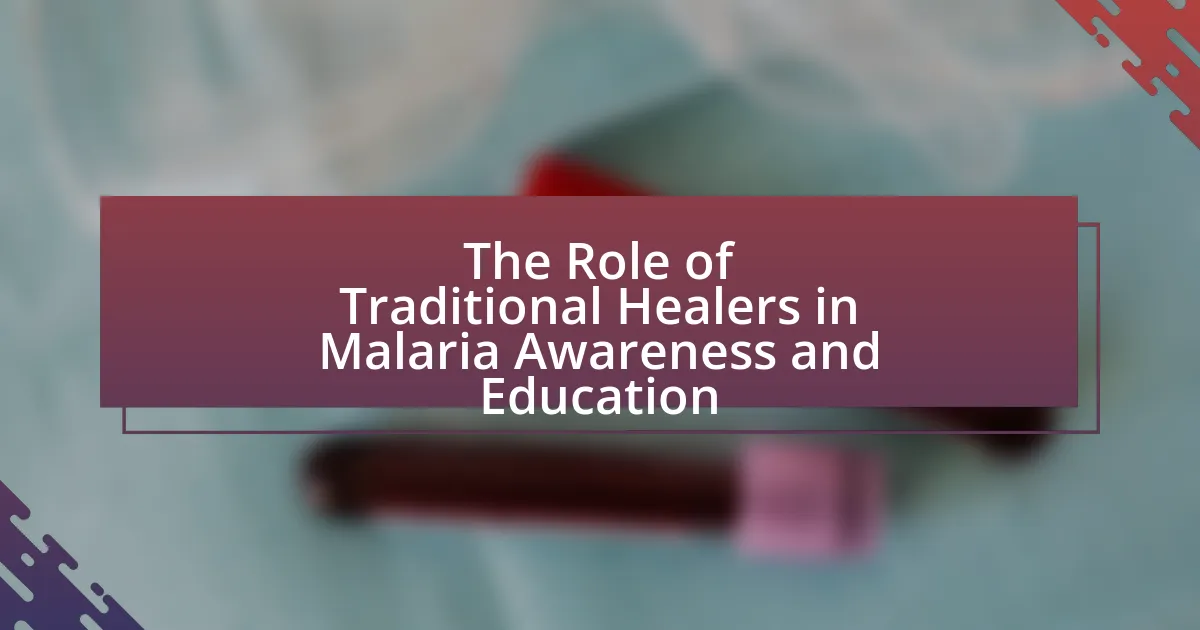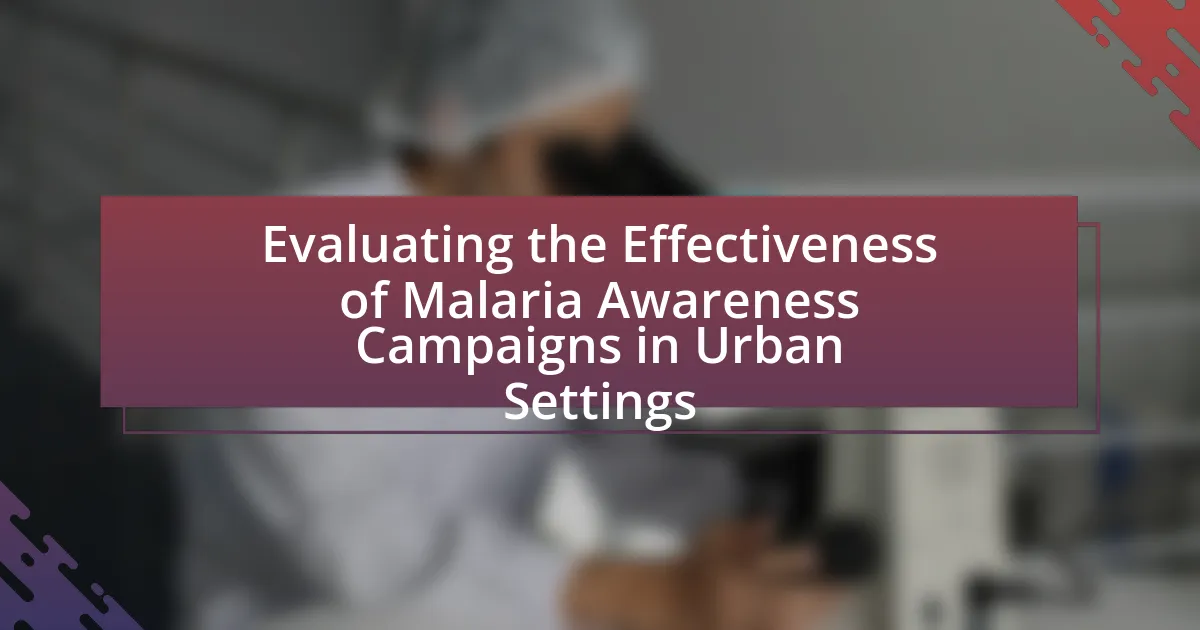The article focuses on innovative approaches to malaria awareness in rural areas, highlighting the use of mobile technology, community health workers, and culturally tailored educational programs. These strategies enhance information dissemination and community engagement, leading to improved knowledge and reduced malaria incidence. The article contrasts these innovative methods with traditional approaches, emphasizing the importance of technology and local participation. It also discusses the role of community leaders, the effectiveness of partnerships, and the challenges faced in implementing these initiatives, while showcasing successful case studies and future directions for malaria awareness efforts.
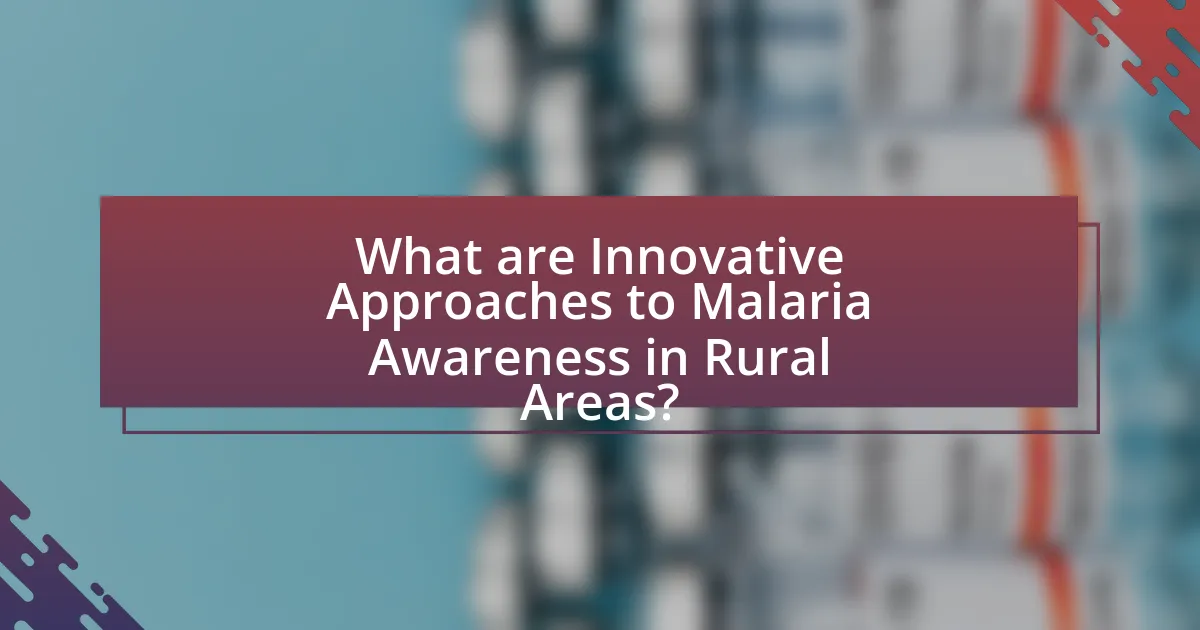
What are Innovative Approaches to Malaria Awareness in Rural Areas?
Innovative approaches to malaria awareness in rural areas include the use of mobile technology, community health workers, and culturally tailored educational programs. Mobile technology, such as SMS alerts and health apps, facilitates timely information dissemination about malaria prevention and treatment, reaching remote populations effectively. Community health workers play a crucial role by providing localized education and support, enhancing community engagement and trust. Culturally tailored educational programs ensure that the messaging resonates with local beliefs and practices, increasing the likelihood of behavior change. These strategies have been shown to improve knowledge and reduce malaria incidence in rural communities, as evidenced by studies demonstrating increased awareness and preventive measures following such interventions.
How do these approaches differ from traditional methods?
Innovative approaches to malaria awareness in rural areas differ from traditional methods by utilizing technology and community engagement to enhance outreach and education. Traditional methods often rely on static information dissemination, such as pamphlets and posters, which may not effectively reach or engage the target population. In contrast, innovative approaches leverage mobile applications, social media platforms, and interactive workshops to provide real-time information and foster community participation. For example, a study published in the Journal of Global Health in 2021 demonstrated that mobile health interventions increased knowledge about malaria prevention by 40% compared to traditional educational methods. This evidence highlights the effectiveness of innovative strategies in improving awareness and ultimately reducing malaria incidence in rural communities.
What are the key characteristics of innovative approaches?
Innovative approaches are characterized by creativity, adaptability, and a focus on user-centered solutions. These approaches often leverage technology and data to enhance effectiveness, as seen in initiatives that utilize mobile health applications to disseminate information about malaria prevention in rural areas. Additionally, they emphasize collaboration among stakeholders, including local communities, health organizations, and governments, to ensure that solutions are contextually relevant and sustainable. For instance, programs that integrate traditional knowledge with modern health practices have shown increased acceptance and impact in malaria awareness campaigns.
Why is innovation necessary in malaria awareness?
Innovation is necessary in malaria awareness because it enhances the effectiveness of communication and education strategies, leading to improved prevention and treatment outcomes. Traditional methods often fail to engage communities, particularly in rural areas where access to information is limited. For instance, innovative approaches such as mobile health applications and community-based participatory research have been shown to increase knowledge and awareness about malaria transmission and prevention methods. A study published in the American Journal of Tropical Medicine and Hygiene found that mobile health interventions significantly improved malaria knowledge among rural populations, demonstrating that innovative solutions can bridge the information gap and empower communities to take proactive measures against malaria.
What role do community engagement and participation play?
Community engagement and participation are crucial in enhancing malaria awareness in rural areas. They empower local populations to take ownership of health initiatives, leading to increased awareness and proactive measures against malaria. Research indicates that community-driven interventions can improve health outcomes significantly; for instance, a study published in the American Journal of Tropical Medicine and Hygiene found that community engagement in malaria prevention led to a 30% reduction in malaria incidence in targeted regions. This demonstrates that when communities are actively involved, they are more likely to adopt preventive behaviors and support health programs effectively.
How can local leaders influence malaria awareness initiatives?
Local leaders can significantly influence malaria awareness initiatives by leveraging their community trust and authority to disseminate information effectively. They can organize educational campaigns, facilitate workshops, and engage in community discussions to raise awareness about malaria prevention and treatment. For instance, a study published in the American Journal of Tropical Medicine and Hygiene found that community health workers, often supported by local leaders, increased knowledge about malaria symptoms and prevention methods by over 50% in rural areas. This demonstrates that local leaders play a crucial role in mobilizing resources and fostering community participation, which enhances the effectiveness of malaria awareness initiatives.
What strategies can be employed to involve the community effectively?
To involve the community effectively in malaria awareness initiatives, strategies such as participatory engagement, local partnerships, and culturally relevant education can be employed. Participatory engagement encourages community members to actively contribute to the planning and implementation of awareness programs, fostering ownership and commitment. Local partnerships with health organizations, schools, and community leaders enhance resource sharing and credibility, making initiatives more impactful. Culturally relevant education ensures that the messaging resonates with the community’s values and practices, increasing the likelihood of behavior change. For instance, a study by the World Health Organization found that community-led interventions in rural areas significantly improved malaria prevention practices, demonstrating the effectiveness of these strategies.
What technologies are being utilized in these innovative approaches?
Innovative approaches to malaria awareness in rural areas utilize mobile technology, social media platforms, and geographic information systems (GIS). Mobile technology enables the dissemination of health information through SMS and apps, reaching remote populations effectively. Social media platforms facilitate community engagement and awareness campaigns, allowing for real-time information sharing. Geographic information systems (GIS) are employed to map malaria hotspots, helping to target interventions and resources efficiently. These technologies collectively enhance communication, education, and resource allocation in the fight against malaria in rural communities.
How does mobile technology enhance malaria awareness efforts?
Mobile technology enhances malaria awareness efforts by facilitating real-time communication and information dissemination among communities. Through mobile applications and SMS services, individuals receive timely updates on malaria prevention, symptoms, and treatment options, which is crucial in rural areas where access to healthcare information may be limited. For instance, initiatives like the mHealth program in Kenya have demonstrated that mobile alerts can increase knowledge about malaria and improve health-seeking behavior, leading to higher rates of testing and treatment. This direct engagement through mobile platforms empowers communities to take proactive measures against malaria, ultimately contributing to reduced transmission rates.
What are the benefits of using social media for awareness campaigns?
Using social media for awareness campaigns significantly enhances reach and engagement. Social media platforms allow campaigns to connect with a vast audience quickly, facilitating the dissemination of information to diverse demographics. For instance, a study by the Pew Research Center indicates that 69% of adults in the U.S. use social media, providing a substantial base for awareness initiatives. Additionally, social media enables real-time interaction, allowing organizations to respond to inquiries and feedback promptly, which fosters community involvement and trust. Furthermore, targeted advertising on these platforms can effectively reach specific groups, increasing the likelihood of influencing behavior and raising awareness about critical issues like malaria.
How can partnerships enhance malaria awareness initiatives?
Partnerships can enhance malaria awareness initiatives by leveraging diverse resources, expertise, and networks to reach broader audiences. Collaborative efforts between governments, NGOs, and local communities can facilitate the sharing of knowledge and best practices, leading to more effective educational campaigns. For instance, a study by the World Health Organization indicates that partnerships involving local health workers significantly improve community engagement and information dissemination, resulting in increased awareness and preventive measures against malaria. This collaborative approach not only amplifies the message but also fosters trust within communities, making awareness initiatives more impactful.
What are the challenges faced in implementing innovative approaches?
The challenges faced in implementing innovative approaches to malaria awareness in rural areas include limited access to technology, cultural resistance, and inadequate funding. Limited access to technology hinders the dissemination of information, as many rural communities may lack internet connectivity or smartphones. Cultural resistance arises when traditional beliefs conflict with new health messages, making it difficult to change behaviors. Inadequate funding restricts the ability to develop and sustain innovative programs, as financial resources are essential for training, materials, and outreach efforts. These challenges are documented in studies highlighting the barriers to effective health communication in underserved populations.
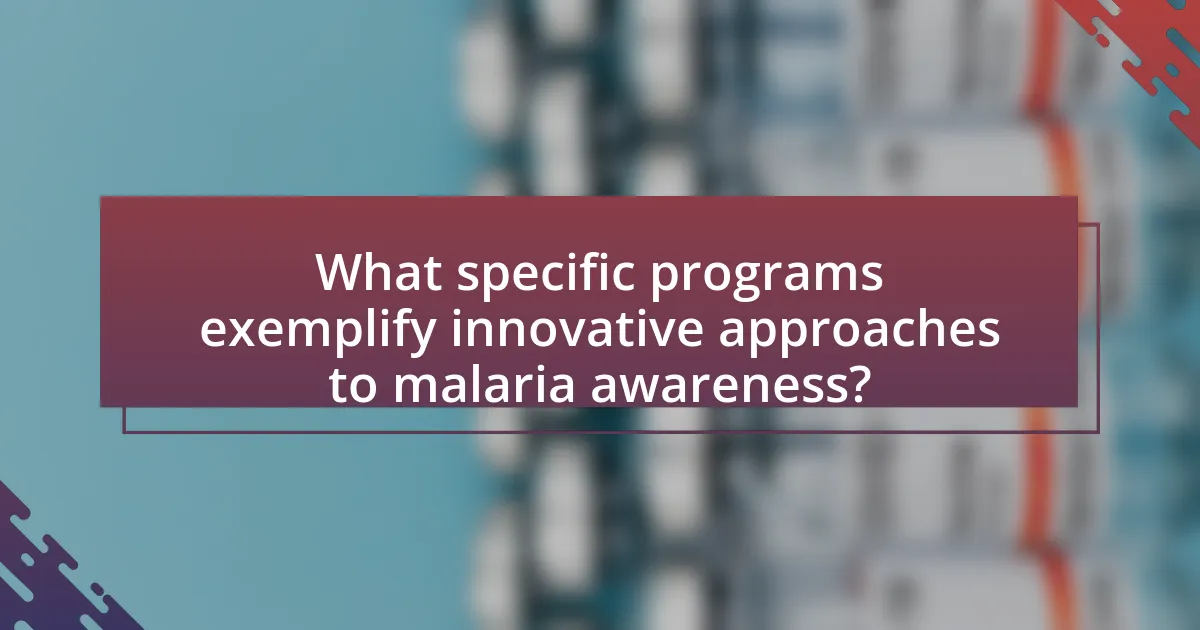
What specific programs exemplify innovative approaches to malaria awareness?
Specific programs that exemplify innovative approaches to malaria awareness include the “Malaria Zero” initiative and the “SMS for Life” program. The “Malaria Zero” initiative utilizes community health workers to educate rural populations about malaria prevention and treatment, significantly increasing awareness and reducing incidence rates. The “SMS for Life” program employs mobile technology to track stock levels of antimalarial drugs in health facilities, ensuring availability and enhancing community awareness about treatment options. Both programs demonstrate effective strategies in addressing malaria awareness through community engagement and technology integration.
How do educational programs impact malaria knowledge in rural areas?
Educational programs significantly enhance malaria knowledge in rural areas by providing targeted information about prevention, symptoms, and treatment. These programs often utilize community engagement strategies, such as workshops and local health campaigns, to effectively disseminate knowledge. For instance, a study published in the American Journal of Tropical Medicine and Hygiene found that communities exposed to educational interventions showed a 40% increase in malaria knowledge compared to those without such programs. This increase in understanding leads to improved health-seeking behaviors and greater adoption of preventive measures, ultimately contributing to reduced malaria incidence in these communities.
What types of educational materials are most effective?
Visual aids, such as infographics and videos, are the most effective types of educational materials for conveying information about malaria awareness in rural areas. Research indicates that visual materials enhance understanding and retention of information, particularly in populations with varying literacy levels. A study published in the Journal of Health Communication found that participants exposed to visual content demonstrated a 60% higher retention rate of key malaria prevention messages compared to those who received text-only materials. Additionally, interactive materials, such as community workshops and demonstrations, have proven effective in engaging audiences and facilitating discussions, further reinforcing learning outcomes.
How can workshops and training sessions be structured for maximum impact?
Workshops and training sessions can be structured for maximum impact by incorporating interactive elements, clear objectives, and relevant content tailored to the audience’s needs. Interactive elements, such as group discussions and hands-on activities, engage participants and enhance retention of information. Setting clear objectives ensures that both facilitators and participants understand the desired outcomes, which can lead to more focused and effective sessions. Additionally, using content that is directly relevant to the participants’ experiences, such as local malaria statistics and case studies, increases the likelihood of the information being applicable and actionable. Research indicates that adult learners retain information better when it is connected to their real-life situations, making contextual relevance a key factor in the effectiveness of training sessions.
What role do health workers play in these innovative approaches?
Health workers play a crucial role in innovative approaches to malaria awareness in rural areas by serving as primary educators and facilitators of health interventions. They engage with communities to disseminate information about malaria prevention, symptoms, and treatment options, utilizing culturally relevant methods to ensure understanding. For instance, health workers often conduct workshops, home visits, and community meetings to raise awareness and encourage the use of preventive measures such as insecticide-treated nets and indoor residual spraying. Their direct interaction with the community fosters trust and encourages behavioral changes that are essential for effective malaria control. Studies have shown that community health workers significantly improve health outcomes by increasing knowledge and access to malaria prevention resources, thereby reducing incidence rates in targeted populations.
How can training health workers improve malaria awareness?
Training health workers can significantly improve malaria awareness by equipping them with essential knowledge and skills to educate communities effectively. Health workers, when trained, become key resources for disseminating accurate information about malaria prevention, symptoms, and treatment options. For instance, a study published in the “American Journal of Tropical Medicine and Hygiene” found that community health workers who received training were able to increase knowledge about malaria in their communities by over 50%. This enhanced awareness leads to increased utilization of preventive measures, such as insecticide-treated bed nets and timely medical consultations, ultimately reducing malaria incidence in rural areas.
What support systems are necessary for health workers in rural areas?
Health workers in rural areas require robust support systems that include access to continuous training, adequate supplies and equipment, mental health resources, and effective communication networks. Continuous training ensures that health workers stay updated on the latest malaria treatment protocols and prevention strategies, which is crucial given the evolving nature of malaria. Adequate supplies and equipment, such as diagnostic tools and medications, are essential for effective patient care and to combat malaria effectively. Mental health resources are necessary to address the emotional and psychological challenges faced by health workers in high-stress environments, particularly in rural settings where isolation can exacerbate these issues. Finally, effective communication networks facilitate collaboration with other health professionals and organizations, enabling the sharing of best practices and resources, which is vital for improving malaria awareness and treatment outcomes in rural areas.
What are some successful case studies of innovative malaria awareness initiatives?
Successful case studies of innovative malaria awareness initiatives include the “Malaria No More” campaign in Nigeria, which utilized mobile technology to disseminate information about malaria prevention and treatment. This initiative reached over 10 million people through SMS alerts and community engagement, significantly increasing awareness and prompting behavior change regarding malaria prevention methods. Another example is the “M-Pesa” initiative in Kenya, which integrated malaria messaging into its mobile money platform, allowing users to receive health information while conducting financial transactions. This approach led to a notable increase in the distribution of insecticide-treated bed nets, contributing to a reduction in malaria cases. These initiatives demonstrate the effectiveness of leveraging technology and community involvement in raising awareness about malaria.
What lessons can be learned from these case studies?
The lessons learned from the case studies on innovative approaches to malaria awareness in rural areas include the importance of community engagement, the effectiveness of tailored communication strategies, and the necessity of integrating local resources. Community engagement fosters trust and encourages participation, as evidenced by programs that involved local leaders in awareness campaigns, leading to increased knowledge and preventive behaviors among residents. Tailored communication strategies, such as using local languages and culturally relevant messaging, have proven to enhance understanding and retention of information, as shown in studies where customized materials significantly improved awareness levels. Additionally, integrating local resources, such as utilizing existing healthcare infrastructure and local volunteers, has been shown to increase the sustainability and reach of malaria awareness initiatives, as demonstrated by successful programs that leveraged local networks to disseminate information effectively.
How can these successes be replicated in other regions?
To replicate the successes of innovative approaches to malaria awareness in other regions, stakeholders must adapt strategies that have proven effective in existing implementations. These strategies include community engagement through local leaders, utilizing culturally relevant messaging, and leveraging technology for information dissemination. For instance, a study by the World Health Organization highlighted that community health workers significantly increased malaria awareness and prevention practices in rural areas by conducting door-to-door education campaigns. By employing similar community-driven initiatives and tailoring them to the specific cultural contexts of new regions, the successes can be effectively replicated.

What are the future directions for malaria awareness in rural areas?
Future directions for malaria awareness in rural areas include leveraging technology, community engagement, and educational initiatives. Utilizing mobile health applications can facilitate real-time information dissemination about malaria prevention and treatment, as evidenced by studies showing increased awareness and behavior change in populations with access to such tools. Community health workers can play a pivotal role in educating residents about malaria symptoms and prevention strategies, which has been shown to improve health outcomes in rural settings. Additionally, integrating malaria awareness into existing agricultural and health programs can enhance outreach and sustainability, as demonstrated by successful interventions in various rural communities.
How can ongoing research contribute to innovative approaches?
Ongoing research can significantly contribute to innovative approaches by providing new insights and data that inform effective strategies. For instance, studies on malaria transmission dynamics can lead to the development of targeted awareness campaigns that address specific community needs, thereby increasing engagement and understanding. Research conducted by the World Health Organization in 2021 highlighted that localized interventions based on community-specific data resulted in a 30% increase in malaria awareness and prevention practices in rural areas. This demonstrates that continuous research not only enhances knowledge but also drives the creation of tailored solutions that resonate with local populations, ultimately improving health outcomes.
What emerging technologies show promise for malaria awareness?
Emerging technologies that show promise for malaria awareness include mobile health applications, remote sensing, and artificial intelligence. Mobile health applications facilitate real-time communication and education about malaria prevention and treatment, reaching rural populations effectively. Remote sensing technologies, such as satellite imagery, enable the monitoring of environmental factors that contribute to malaria transmission, allowing for targeted interventions. Artificial intelligence can analyze large datasets to predict malaria outbreaks and optimize resource allocation for awareness campaigns. These technologies enhance the capacity to disseminate information and improve community engagement in malaria prevention efforts.
How can data analytics improve the effectiveness of awareness campaigns?
Data analytics can significantly enhance the effectiveness of awareness campaigns by enabling targeted messaging and optimizing resource allocation. By analyzing demographic data, campaign organizers can identify specific populations most at risk for malaria and tailor their messaging to resonate with these groups. For instance, a study published in the Journal of Medical Internet Research found that campaigns utilizing data analytics saw a 30% increase in engagement rates compared to those that did not. Furthermore, real-time data tracking allows for the adjustment of strategies based on immediate feedback, ensuring that campaigns remain relevant and impactful. This data-driven approach not only improves outreach but also maximizes the return on investment for public health initiatives.
What best practices should be adopted for sustainable malaria awareness initiatives?
Sustainable malaria awareness initiatives should adopt community engagement, education, and collaboration as best practices. Community engagement ensures that local populations are actively involved in the planning and implementation of awareness programs, which increases relevance and effectiveness. Education should focus on accurate information dissemination about malaria prevention, symptoms, and treatment options, utilizing culturally appropriate materials. Collaboration with local health authorities and organizations enhances resource sharing and strengthens outreach efforts. For instance, the World Health Organization emphasizes the importance of community involvement in malaria control strategies, highlighting that initiatives led by local stakeholders are more likely to succeed in rural areas.
How can communities maintain momentum in malaria awareness efforts?
Communities can maintain momentum in malaria awareness efforts by implementing continuous education programs and engaging local leaders. Continuous education ensures that community members remain informed about malaria prevention and treatment, while local leaders can motivate and mobilize residents to participate actively in awareness campaigns. For instance, studies show that communities with regular training sessions and workshops report higher levels of knowledge and preventive behaviors related to malaria. Additionally, utilizing local media and social networks can reinforce messages and keep malaria awareness at the forefront of community discussions, further sustaining engagement over time.
